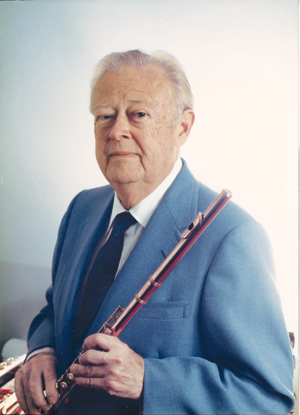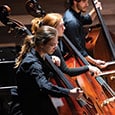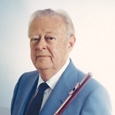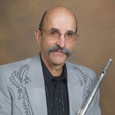 Harold Bennett (1913-1985) was born and raised in Sheridan, Wyoming. He studied flute with his friend, Maurice Sharp (1908-1986, Cleveland Orch-estra principal flute for 50 years) who was several years older. They played flute together in a vaudeville theatre owned by Sharp’s father. When Sharp left to study with William Kincaid at The Curtis Institute, he convinced Bennett to join him several years later. After Bennett’s graduation from Curtis in 1935, he played principal flute in the National Symphony, the Radio City Music Hall Orchestra, and the Pittsburgh Symphony. From 1940 – 1944, he was assistant principal and piccolo in the Philadelphia Orchestra alongside his teacher, William Kincaid. Bennett was principal flute in the New York Metropolitan Opera Orchestra from 1944 to 1965.
Harold Bennett (1913-1985) was born and raised in Sheridan, Wyoming. He studied flute with his friend, Maurice Sharp (1908-1986, Cleveland Orch-estra principal flute for 50 years) who was several years older. They played flute together in a vaudeville theatre owned by Sharp’s father. When Sharp left to study with William Kincaid at The Curtis Institute, he convinced Bennett to join him several years later. After Bennett’s graduation from Curtis in 1935, he played principal flute in the National Symphony, the Radio City Music Hall Orchestra, and the Pittsburgh Symphony. From 1940 – 1944, he was assistant principal and piccolo in the Philadelphia Orchestra alongside his teacher, William Kincaid. Bennett was principal flute in the New York Metropolitan Opera Orchestra from 1944 to 1965.
I met Harold Bennett in 1969. I had just graduated from the Hartt School of Music and was a member of the Army band stationed at West Point, New York. I wanted to continue my studies so I asked members of the flute section for recommendations for teachers in New York City. Bennett came highly recommended. I contacted him in the fall and was put on a waiting list. My first lesson was in December. At that time Bennett had retired from the Metropolitan Opera Orchestra and had 80 students, which included a large flute studio at Manhattan School of Music. My hour lessons were scheduled every other week.
When I heard him play in my first lesson, I realized that a rich and vibrant flute sound, void of surface noise, was possible. I also realized he had the ability to project through a symphony orchestra in a large auditorium. His tone was the most resonant and pure flute sound that I had ever heard. From that point on, I was determined to acquire that type of sound not only by emulating his playing, but by studying how his embouchure looked, applying everything he suggested, and even recording my lessons (on cassette tapes in those days).
Bennett was a strong advocate of William Kincaid’s pedagogy. He did not just ask me to imitate his playing but was very good at explaining how things were to be done. As a result, he was also a very popular teacher among the New York City’s woodwind doublers. Like many of Kincaid’s students, Bennett had a masterful technique. He was absolutely insistent on the right pinky being down for all regular fingerings that require it. He also insisted that students use the right middle finger for the first trill key (as in fingering high Bb) and the third finger for the second trill key (as in fingering high B). This builds up the weaker fingers, and the technique becomes stronger.
Each lesson started with him checking my flute over very carefully and adjusting any leaks that might have occurred between lessons. This got me used to expecting my flute to respond at a very high level. I realized that many problems I thought I had were actually mechanical ones.
During the first year of my four years of study with him, we concentrated on long tones and tuning with a vibraphone. He used the vibraphone because with the pedal depressed, the tone sustains for a long time. Then it was on to Andersen Etudes. He always had me play them with the metronome and insisted that all breaths be taken in rhythm without omitting any notes. I learned to work through what I call “the suffocation stage.” At first, as many breaths as needed were taken; but as efficiency improves, many of the breaths were eliminated. Then we went on to repertoire pieces. When he demonstrated the phrasing, I was always amazed how such a soft-spoken person could play with so such emotion and command of every detailed nuance.
What I liked best about Bennett’s pedagogy was the independence of variables for pitch and dynamics. He taught how to use the embouchure plus various fingerings to control the pitch, while using the amount of air and compensating jaw positions to control dynamics (ff – jaw back and down, mf – jaw comfortable, pp – jaw forward). This enabled me to dramatically improve my control of the flute. Many years later, while working with Louis Moyse in our Moyse Duo, Louis said to me, “John, you have great control of the flute, but I don’t know what you are doing.” Thanks Harold! I have had many wonderful teachers, but credit Harold Bennett for helping me find my musical footing which enabled me to go on and develop my own style.
As time went on, Bennett recommended me for a job with Artley as a clinician. He was a design consultant for Artley and soon began inviting me along as his assistant. During the final years of his life, we were both design consultants for Muramatsu, along with Ervin Monroe. After Bennett passed away, just several weeks after the Denver NFA Convention in 1985, a huge honor was bestowed upon me. Bennett’s wife, Carol, and daughter, Marsha, asked me to perform his favorite opera solo, “Minuet and Dance of the Blessed Spirits” by Gluck, at his memorial service on his flute. I do not think my career would have been as successful without the help and friendship of Harold Bennett.





